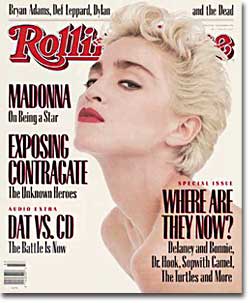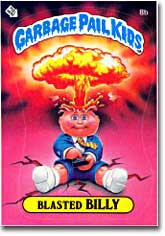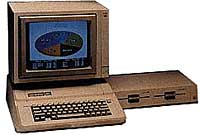59d. Life in the 1980s

"I want my MTV."
Americans enjoyed many fundamental changes in their standard of living in the 1980s. One major transformation was the new, expanded role of television. Cable television, although available in the 1970s, became standard for most American households. This change ushered in a whole host of new programming.
Sports-minded Americans could watch the ESPN network 24 hours a day. Nickelodeon catered to the children of the baby boomers with youth-centered daily programming, and to the boomers themselves by broadcasting reruns of classic sitcoms at night. Americans could catch up with the news at any time by watching CNN.
MTV, or Music Television, brought a revolution to the recording industry. MTV broadcast music video interpretations of popular songs. Beginning in 1981 with the prophetic Buggles tune "Video Killed the Radio Star," MTV redefined popular music. Stars like Madonna and Michael Jackson were much more able to convey an image as well as music. Madonna's "Material Girl" message typified the values of an increasingly materialistic decade.

Rude, crude, and with a bad attitude, the "Garbage Pail Kids" collector cards took the U.S. by storm in the 1980s. With names like "Potty Scotty" and "Barfin' Barbara," these kids were a reaction to one of the decades other fads — the Cabbage Patch Kids.
The videocassette recorder (VCR) allowed Americans to record television shows and watch them according to their own schedule and view feature films in the privacy of their own homes.
Perhaps the product that introduced the greatest change in American lifestyles of the 1980s was the personal computer. Introduced by Apple in 1977, the personal computer allowed management of personal finances, quick word-processing, and desktop publishing from the home. Businesses could manage payroll, mailing lists, and inventories from one small machine. Gone were the ledgers of the past. The Silicon Valley of California, which was the home to many of the firms that produced the processors that made these computers run, became the symbolic heart of the American technological economy.
"Greed is good," declared the lead character of the movie Wall Street. With the growing economy, many middle-class Americans rushed to invest in the bullish stock market and to flaunt their newly acquired wealth. Young Urban Professionals, or yuppies, replaced the socially conscious hippie of the previous generation of youth. Yuppies sought executive track jobs in large corporations and spent their money on upscale consumer products like Ray-Ban sunglasses, Polo apparel, and Mercedes and BMW automobiles. The health and fitness industry exploded as many yuppies engaged in regular fitness routines.

The computing revolution of the 1980s began with the introduction of the Apple II series. Sometimes referred to as the "Model-T" of computers, the Apple II allowed businesses to streamline operations and brought the wonders of digital data management into the home.
The hedonism of the 1970s was being re-evaluated. Many drugs, which were considered recreational in the '70s, were revealed as addictive, deadly substances. As reports of celebrities entering rehabilitation centers and the horrors of drug-ridden inner cities became widely known, First Lady Nancy Reagan's message to "Just Say No" to drugs became more powerful. Regardless, newer and more dangerous substances like crack cocaine exacerbated the nation's drug problem.
The sexual revolution was rocked by the spread of Acquired Immune Deficiency Syndrome, or AIDS. This deadly disease was most commonly communicated by sexual contact and the sharing of intravenous needles. With the risks of promiscuous behavior rising to a mortal level, monogamy and "safe sex" with condoms were practiced more regularly.
While greed may have been rewarded in the '80s, lust, be it for drugs or sex, proved fatal for thousands.






